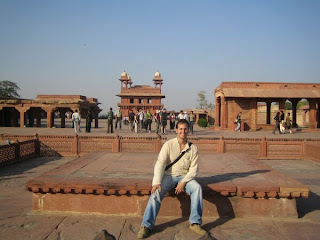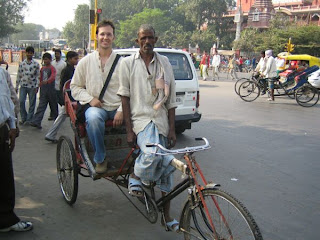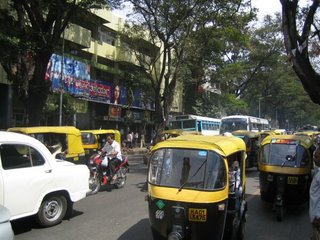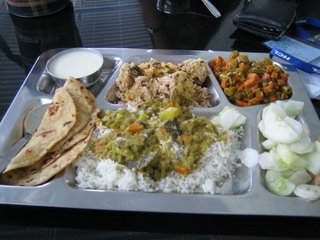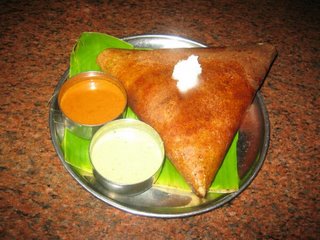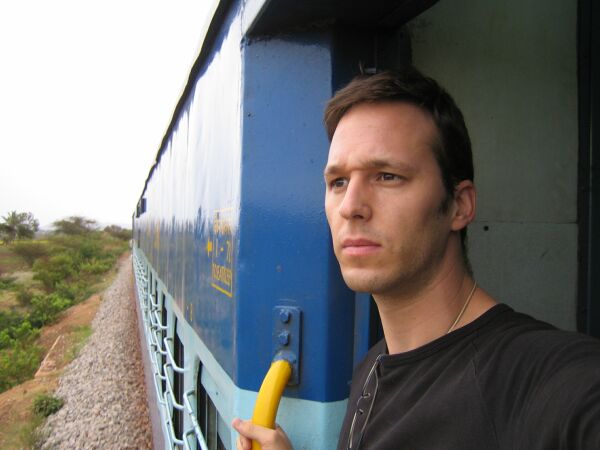On the 18th November, finally, I took off from Bangalore for New Delhi. It was the first destination of my two weeks trip around Rajasthan, one of India's most impressive states. New Delhi itself like Agra by the way are not part of Rajasthan. But in any case, being in India includes having seen the capital as well as the Taj Mahal, located in Agra. After a 2 1/2 hours flight I landed in New Delhi on time, more or less at least. When we were about to land, the aircraft soared up again. Nobody was wondering why this had happened as it would have been something normal. Well, as for me, I was wondering, if we have been hijacked. Actually, I was pretty sure about it. But then, after one minute of incertainty, the pilot informed us, saying there had been some birds on the runway all of a sudden.

As I switched on my phone, I noticed that it was not working anymore. The day before, I activated "roaming"; at least I thought I would have done. "How to get in touch with Karolina now", I asked myself. Karolina is from Poland. I met her in Bangalore. She is also a trainee. As we both wanted to travel around Rajasthan, we decided to go there together. But she arrived in New Delhi already the day before. "So what, first I have to go to New Delhi Train station", I said myself. Karolina and me arranged an appointment at New Delhi Train station for 10 o'clock. In front of the airport, I was asked by taxi drivers where I would like to go. I refused to go by taxi as I had planned to go there by metro. But unfortunately, there is still no metro going to the airport. I was pretty sure that there is one, but I was mistaken. All of a sudden, I guy offered me to go there by his own shabby bus for 50 Rps and I agreed. After some time the bus built for 8 people has become crowed. At the end, he conveyed 14 people in the bus. During the way to the train station I was surprised about the cleanness in the streets. "Well, it is the capital of India, so it has to be clean", I explained myself. To be honest, I was missing the garbage and the cows in the streets. But I can already reveal, the garbage and cows would be still coming. Arrived at the train station, I had an impressive view of Paharganj, a messy and polluted area of Delhi. This area is what I consider to be the real India; bustling people trying to sell their stuff, Indians hanging about and cows and dogs rummaging in garbage for something eatable. And then this nice taxi cabs standing in front of the rainway station, the body in black and the roof in yellow. I decided to make a phone call from one of the public telephone cabins, called STD/ISD as couldn't find Karolina. After a while, I finally found Karolina then. We edged our ways through the main street of Paharganj while we were asked by more or less all the vendor whether we would be interested in their merchandizes. We refused every time. After having checked in at Vivek Hotel, we had a breakfast on the hotel's rooftop restaurant. From there, I had an awesome view in this bustling street. In the late morning, we decided to hire a cab for 600 Rps for a sightseeing tour in Delhi.

Our driver promised that we would see all the important monuments, which, we noticed later, is impossible because of two reasons. First, there is too much to see and second, the admission is only possible till the sunset, what is at about 5.30pm. Nevertheless, we have covered quite a good many things like Birla Temple, built by the Birlas, an industrialist family in 1938 or the Parliament House. Close to the Parliament House, India Gate, also known as All India War Memorial, is located. It looks similar to the "Arch de Triomphe" in Paris and is dedicated to the 80.000 soldiers who died in the World War 1 and the Afghan wars. In addition to that, we went to Qutub Minar, a monument built in 1199 by Qutub-Ud-Din-Aibak in order to give calls for prayer. Built out of sandstone, it is India's highest tower with a height of 72,5m.

It is one of New Delhi's most attracting sightseeing. Therefore, it was very crowded by tourists and Indians scattering themselves. As the sun was already about to set, we rushed to the Lotus Temple. It is a place of praying for people of all religions. The fact that it looks like a lotus blossom, gave the temple its name. It is surrounded by a beautiful green garden. The monument we were able to see, was Humayun's Tomb. It was designed and erected by Humayun's queen Hamida Banu Begam in 1570. Humayun's Tomb was the first garden tomb in the subcontinent. With its red and white sandstone it looks really overwhelming. As it is believed having inspired several other Mughal architectural innovations like the Taj Mahal,

I was anxious to see it; but I would not see it before the 20th. While we were hanging about at Humayun's Tomb, the sun had set completely. Therefore, we requested our driver to drop us at Connaught Place, a big shopping and business circus, from where we took a rickshaw to Paharganj after having gone for a walk. The evening then we spent at Paharganj, went shopping and ate some good food in one this cheap restaurants. Especially shopping is recommendable there. It is cheap and you have big offer of things like jewelry, clothes, carpets, tissues and so on. I bought some stuff, of course which might have meant for you. Be anxious. In comparision to Bangalore, at Paharganj, it is much fun to bargain.

If you have a glance to one of the shops, you will be asked to enter the vendor's shop, for sure. Well, and then you show a little interest, the vendor utters a prize, you reduce it by the half and try to move on. After having told a prize in between yours and the vendor's at the beginning, the vendor now all of a sudden accepts your prize and you get what you want. You can be sure, it works - always. And if not, don't worry, there are so many shops. You will get what you want for a reasonable prize.
 trying make business. As the restaurant was in near distance, we preferred to go there on foot. From the beginning on, Jaipur made to me a very pleasant impression. Especially, when we approached the Cill Wall. The older part of the city is surrounded by a huge wall made of red sandstone. There are only a few possibilities for entering this part of the city. But once you have left the wall behind you, we will have a great view of Jaipur’s streets,
trying make business. As the restaurant was in near distance, we preferred to go there on foot. From the beginning on, Jaipur made to me a very pleasant impression. Especially, when we approached the Cill Wall. The older part of the city is surrounded by a huge wall made of red sandstone. There are only a few possibilities for entering this part of the city. But once you have left the wall behind you, we will have a great view of Jaipur’s streets, all tarried with buildings made of red sandstone and constructed in very certain manner. That’s the reason why Jaipur is also called the pink city. First we simply were hanging about the Bazaar. It is a real shopping area, where you can find all kind of stuff, clothing of course in particular. At each shop we passed vendors invited us to enter their shop for simply having a look what he is offering. Indeed, we were interested in some clothes, but in order to get a good price you should never show your interest. Therefore rummaged the displays for a while, then asked for the price and decided to move on. He vendors were certain to follow by calling a reduced price.
all tarried with buildings made of red sandstone and constructed in very certain manner. That’s the reason why Jaipur is also called the pink city. First we simply were hanging about the Bazaar. It is a real shopping area, where you can find all kind of stuff, clothing of course in particular. At each shop we passed vendors invited us to enter their shop for simply having a look what he is offering. Indeed, we were interested in some clothes, but in order to get a good price you should never show your interest. Therefore rummaged the displays for a while, then asked for the price and decided to move on. He vendors were certain to follow by calling a reduced price. Finally, I went for 2 pairs of shoes and a couple of shirts, most of them with a typical Indian symbol, like a camel or an elephant embroidered on it. Really beautiful, I tell you. Be anxious, one of them might be gifted to you. After having finished our shopping tour, we more focussed on doing some sightseeing in Jaipur.
Finally, I went for 2 pairs of shoes and a couple of shirts, most of them with a typical Indian symbol, like a camel or an elephant embroidered on it. Really beautiful, I tell you. Be anxious, one of them might be gifted to you. After having finished our shopping tour, we more focussed on doing some sightseeing in Jaipur. The building Jaipur is famous for is the Hawa Mahal. It was build by the Maharaja in 1799 for his wifes, so that they were able to observe the processions held on the streets without being seen themselves. The Hawa Mahal is quite an impressive building, almost similar to the Taj Mahal. We climped up the small stairs through its little passages and once arrived behaved like the women 200 years ago by sitting behind the window and watching the goings on the street.
The building Jaipur is famous for is the Hawa Mahal. It was build by the Maharaja in 1799 for his wifes, so that they were able to observe the processions held on the streets without being seen themselves. The Hawa Mahal is quite an impressive building, almost similar to the Taj Mahal. We climped up the small stairs through its little passages and once arrived behaved like the women 200 years ago by sitting behind the window and watching the goings on the street. After the Hawa Mahal we went to the City Palace, sightseeing in Jaipur worth having a look at it. On the way to the City Palace, we saw a child shitting next to the street. As I was not eager on observing it, I immediately averted my eyes of it. Unfortunately, we couldn’t enter the Palace. But the Palace domiciles two interesting museums exposing weapons and clothes of that time. We really had the feeling being back to the 18th century.
After the Hawa Mahal we went to the City Palace, sightseeing in Jaipur worth having a look at it. On the way to the City Palace, we saw a child shitting next to the street. As I was not eager on observing it, I immediately averted my eyes of it. Unfortunately, we couldn’t enter the Palace. But the Palace domiciles two interesting museums exposing weapons and clothes of that time. We really had the feeling being back to the 18th century. Also because of the guardians who were wearing typical uniforms. Next to City Palace the Maharaja built his own planetarium. A few interesting devices were part of the planetarium. Quite striking how the observed the stars in the former time. When the sun was already about to set, we climbed up to the Nahargrat Fort which was a retreat.
Also because of the guardians who were wearing typical uniforms. Next to City Palace the Maharaja built his own planetarium. A few interesting devices were part of the planetarium. Quite striking how the observed the stars in the former time. When the sun was already about to set, we climbed up to the Nahargrat Fort which was a retreat. All the room were painted in the same style with very sophisticated patterns. It was told these rooms were used for the Maharaja love acts with his wifes. From Nahargrat Fort we had a great view over Jaipur and attended a romantic sun set. The day then ended with a nice dinner on a roof top’s restaurant.
All the room were painted in the same style with very sophisticated patterns. It was told these rooms were used for the Maharaja love acts with his wifes. From Nahargrat Fort we had a great view over Jaipur and attended a romantic sun set. The day then ended with a nice dinner on a roof top’s restaurant.







